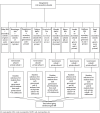Level and Associated Factors of Knowledge regarding Menstrual Hygiene among School-Going Adolescent Girls in Dang District, Nepal
- PMID: 33145112
- PMCID: PMC7599395
- DOI: 10.1155/2020/8872119
Level and Associated Factors of Knowledge regarding Menstrual Hygiene among School-Going Adolescent Girls in Dang District, Nepal
Abstract
Background: Adolescent girls in developing countries do not have proper information, and proper information is covered up by sociocultural boundaries resulting in various morbidities. This study aimed to determine level of knowledge and its associated factors regarding menstrual hygiene amongst adolescent school girls in Dang district, Nepal.
Methods: Institution-based cross-sectional study was conducted between April and October 2019 among 406 adolescent girls studying in grades 8-10 between ages of 10-19 years in Dang district, Nepal. From a total of 10 local units, 5 were selected randomly. Out of the selected 5 units, 10 schools consisting of 5 government and 5 private schools were selected through disproportionate stratified random sampling. A further 406 students were then selected randomly from the 10 selected schools. Bivariate analysis was used primarily to assess the association between dependent and independent variables. Variables which were associated with bivariate analysis were entered into a multivariable logistic regression model to identify associated factors of menstrual hygiene practice.
Results: The mean age and family size were 15.13 ± 1.19 and 5.58 ± 1.81, respectively. A total of 87.7% of adolescents had good knowledge regarding menstrual hygiene. Adolescents living in rural area (AOR = 0.27, CI: 0.12-0.61, p ≤ 0.001), private schools (AOR = 6.10, CI: 1.58-23.46, p ≤ 0.001), mothers who can read and write (AOR = 0.22, CI: 0.07-0.64, p ≤ 0.001), fathers who have up-to-grade-10 education (AOR = 5.15, CI: 1.84-14.39, p ≤ 0.001), and living only with mothers (AOR = 0.29, CI: 0.12-0.69, p ≤ 0.018) were significantly associated with level of knowledge of menstrual hygiene.
Conclusions: Though the majority of respondents had a good level of knowledge regarding menstrual hygiene, there was a knowledge gap in specific areas. The level of knowledge was significantly poor among adolescents in rural areas and those living only with mothers. Thus, this study concerns the need for policy makers to focus on specific education regarding menstrual hygiene in rural areas including both parents.
Copyright © 2020 Chet Kant Bhusal et al.
Conflict of interest statement
The authors declare that there are no conflicts of interest.
Figures
Similar articles
-
Practice of Menstrual Hygiene and Associated Factors among Adolescent School Girls in Dang District, Nepal.Adv Prev Med. 2020 Jul 24;2020:1292070. doi: 10.1155/2020/1292070. eCollection 2020. Adv Prev Med. 2020. PMID: 32774926 Free PMC article.
-
Assessment of menstrual hygiene management knowledge, practice, and associated factors among girls in Boset District, Ethiopia: a school-based cross-sectional study.Contracept Reprod Med. 2023 Jun 1;8(1):34. doi: 10.1186/s40834-023-00233-z. Contracept Reprod Med. 2023. PMID: 37259164 Free PMC article.
-
Safe menstrual hygiene management practice and associated factors among female adolescent students at high schools in central Ethiopia: A mixed-method study.Front Public Health. 2022 Jul 26;10:913262. doi: 10.3389/fpubh.2022.913262. eCollection 2022. Front Public Health. 2022. PMID: 35958860 Free PMC article.
-
Menstrual hygiene management knowledge, practice and associated factors Among School Girls, Northeast Ethiopia.PLoS One. 2022 Jul 19;17(7):e0271275. doi: 10.1371/journal.pone.0271275. eCollection 2022. PLoS One. 2022. PMID: 35852998 Free PMC article.
-
Earning pocket money and girls' menstrual hygiene management in Ethiopia: a systematic review and meta-analysis.BMC Womens Health. 2022 Jul 4;22(1):271. doi: 10.1186/s12905-022-01855-2. BMC Womens Health. 2022. PMID: 35787677 Free PMC article.
Cited by
-
Awareness and Practices of Menstrual Hygiene Among Rural Adolescent Schoolgirls in Lahore, Pakistan: A Cross-Sectional Study.Cureus. 2024 Nov 18;16(11):e73899. doi: 10.7759/cureus.73899. eCollection 2024 Nov. Cureus. 2024. PMID: 39697906 Free PMC article.
-
Menstruation hygiene management among secondary school students of Chitwan, Nepal:a cross-sectional study.BMC Womens Health. 2023 Jul 26;23(1):395. doi: 10.1186/s12905-023-02494-x. BMC Womens Health. 2023. PMID: 37495966 Free PMC article.
-
Primary Dysmenorrhea Associated with Psychological Distress in Medical Sciences Students in The North of Iran: A Cross-Sectional Study.Int J Fertil Steril. 2022 Aug 21;16(3):224-229. doi: 10.22074/ijfs.2022.542056.1216. Int J Fertil Steril. 2022. PMID: 36029061 Free PMC article.
-
Health Issues Among Nepalese Youth: A Literature Review.Cureus. 2023 Sep 12;15(9):e45108. doi: 10.7759/cureus.45108. eCollection 2023 Sep. Cureus. 2023. PMID: 37842493 Free PMC article. Review.
References
-
- Bathija G. V., Bant D. D., Itagimath S. R. Study on usage of woman hygiene kit among menstruating age group in field practice area of Kims, Hubli. International Journal of Biomedical Research. 2013;4(2):94–98. doi: 10.7439/ijbr.v4i2.233. - DOI
-
- Bachloo T., Kumar R., Goyal A., et al. A study on perception and practice of menstruation among school going adolescent girls in district Ambala Haryana, India. International Journal of Community Medicine and Public Health. 2017;3(4):931–937. doi: 10.18203/2394-6040.ijcmph20160931. - DOI
LinkOut - more resources
Full Text Sources
Miscellaneous


